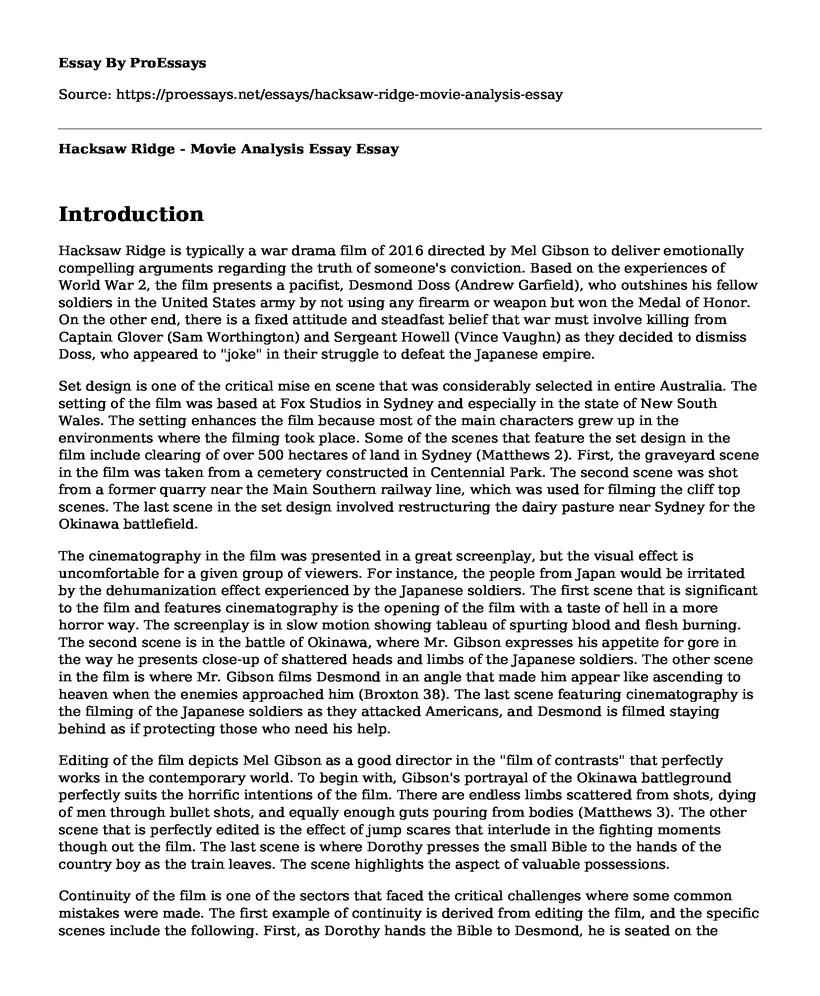Introduction
Hacksaw Ridge is typically a war drama film of 2016 directed by Mel Gibson to deliver emotionally compelling arguments regarding the truth of someone's conviction. Based on the experiences of World War 2, the film presents a pacifist, Desmond Doss (Andrew Garfield), who outshines his fellow soldiers in the United States army by not using any firearm or weapon but won the Medal of Honor. On the other end, there is a fixed attitude and steadfast belief that war must involve killing from Captain Glover (Sam Worthington) and Sergeant Howell (Vince Vaughn) as they decided to dismiss Doss, who appeared to "joke" in their struggle to defeat the Japanese empire.
Set design is one of the critical mise en scene that was considerably selected in entire Australia. The setting of the film was based at Fox Studios in Sydney and especially in the state of New South Wales. The setting enhances the film because most of the main characters grew up in the environments where the filming took place. Some of the scenes that feature the set design in the film include clearing of over 500 hectares of land in Sydney (Matthews 2). First, the graveyard scene in the film was taken from a cemetery constructed in Centennial Park. The second scene was shot from a former quarry near the Main Southern railway line, which was used for filming the cliff top scenes. The last scene in the set design involved restructuring the dairy pasture near Sydney for the Okinawa battlefield.
The cinematography in the film was presented in a great screenplay, but the visual effect is uncomfortable for a given group of viewers. For instance, the people from Japan would be irritated by the dehumanization effect experienced by the Japanese soldiers. The first scene that is significant to the film and features cinematography is the opening of the film with a taste of hell in a more horror way. The screenplay is in slow motion showing tableau of spurting blood and flesh burning. The second scene is in the battle of Okinawa, where Mr. Gibson expresses his appetite for gore in the way he presents close-up of shattered heads and limbs of the Japanese soldiers. The other scene in the film is where Mr. Gibson films Desmond in an angle that made him appear like ascending to heaven when the enemies approached him (Broxton 38). The last scene featuring cinematography is the filming of the Japanese soldiers as they attacked Americans, and Desmond is filmed staying behind as if protecting those who need his help.
Editing of the film depicts Mel Gibson as a good director in the "film of contrasts" that perfectly works in the contemporary world. To begin with, Gibson's portrayal of the Okinawa battleground perfectly suits the horrific intentions of the film. There are endless limbs scattered from shots, dying of men through bullet shots, and equally enough guts pouring from bodies (Matthews 3). The other scene that is perfectly edited is the effect of jump scares that interlude in the fighting moments though out the film. The last scene is where Dorothy presses the small Bible to the hands of the country boy as the train leaves. The scene highlights the aspect of valuable possessions.
Continuity of the film is one of the sectors that faced the critical challenges where some common mistakes were made. The first example of continuity is derived from editing the film, and the specific scenes include the following. First, as Dorothy hands the Bible to Desmond, he is seated on the passenger side of the bus, but after the bus departures, he is on the opposite side. The second scene is where Desmond's wounds on the face change position and size while reading the Bible (Broxton 45). The second example of continuity is derived from cinematography, as depicted in the following scenes. First, there is no knife in the Japanese soldier's stomach when he stabbed himself. The second scene is where the sun keeps on changing when Desmond assists Dorothy to climb the hill.
In a wrap-up, the Hacksaw Ridge film is a success story of Desmond Doss, who tried to fight a battle without any physical weapon but rather religion. However, the depiction of the film appears to be dehumanizing and especially to the people from Japanese origin because of the scenes present rough and mass killing of the Japanese soldiers in a war. However, there is no depth of characterization in the film, and any viewer may not feel much for the characters whether they died or lived because the film is unreal.
Works Cited
Broxton, Jonathan. "HACKSAW RIDGE - Rupert Gregson-Williams." Movie Music UK. (November 1, 2016). Retrieved November 10, 2017.
Matthews, Joshua. "Hacksaw Ridge: A Movie Review." (2017).
Cite this page
Hacksaw Ridge - Movie Analysis Essay. (2023, May 18). Retrieved from https://proessays.net/essays/hacksaw-ridge-movie-analysis-essay
If you are the original author of this essay and no longer wish to have it published on the ProEssays website, please click below to request its removal:
- Paper Example on Vitruvius Model
- Jean Pierre Melville's Bibliography
- Film Analysis Essay on 'The Death of Stalin'
- Yoguslav the Black Wave Essay Example
- Essay Example on Exploring Social Identity Through Media Messages
- Essay Example on Mystery and Vanishing: Picnic at the Hanging Rock
- Gratification Theory & Social Media: Exploring the Relationship - Essay Sample







